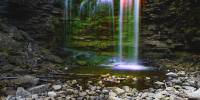
Hilton Falls Conservation Area
Along the Niagara Escarpment in Southern Ontario, Canada
June 21, 2005. 22:20UTC (18:20 EST)
© 2005 Francis Fougere, All Rights Reserved.
The Sawmills of Hilton Falls On the brow of Hilton Falls the remains of three 19th Century sawmills can still be found. The first mill was constructed by Edward Hilton in 1835 and supplied Nassagaweya Township with lumber. Unfortunately, Hilton supported William MacKenzieís abortive rebellion in 1837 and had to flee to the United States and leave his mill to fall into disrepair. It wasn't until 1856, when George Park acquired the property that Hilton Falls once again became the site of an active mill. The substantial stone ruins that exist today, indicate that a well-built mill building and dam were constructed by the Ancaster doctor. Records indicate that an immense 40 foot diameter water wheel powered the mill. Park sold his operation in 1857 and it burned down in 1860. Virtually nothing is known about the third and last mill constructed by John Richards. It began operation in 1863 and continued until it burned in 1867. After the final mill burned, the water power of Hilton Falls was no longer used.
Lat: 43° 30' 34.8" N
Long: 80° 59' 45.3" W
Elevation: 779 FT.
Precision is: Unknown / Undeclared.


 Tap or click the zoom icon in the bottom right corner of the picture to switch between in-page and fullscreen view
Tap or click the zoom icon in the bottom right corner of the picture to switch between in-page and fullscreen view